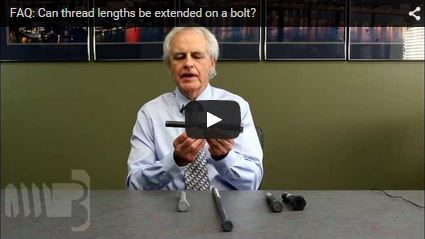Extending Thread Lengths

Basically, there are 3 different configurations of threads:
- Full-body cut thread
- Reduced-body rolled threads
- Full-body rolled threads
Full Body Cut Thread
Full body cut threads use full size round bar and the threads are cut into the steel. This is a commonly used method, especially on larger diameter products, long length products, and small quantity runs. This thread configuration can have the threads extended. We have to line up the threading dies with the existing threads and then continue cutting threads up to the new desired thread length. One note though, if the parts are hot-dip galvanized, we must strip the parts of the galvanizing, re-thread, then re-galvanize. It may be just as cost-effective to remake the parts in this situation.
Reduced Body Rolled Threads
Reduced body rolled threads are made using pitch diameter round bar which is ½ way between the OD of thread and the root diameter, so the threads can be formed through a rolling process. This type of thread is commonly found on right angle bend anchor bolts and product manufactured to the ASTM F1554 anchor bolt specification. Some companies may be willing to extend rolled threads, but this is not an option for us. It is extremely easy to ruin a set of threading dies when rerolling bolts. Therefore, this is something we are not willing to do. Cutting additional thread length will not work on pitch diameter material.
Full Body Rolled Threads
Full body rolled threads use full-size material that gets extruded down to pitch diameter and then the threads are rolled. This is a commonly used method for cold headed product like A325 structural bolts. The product is small diameter, short length, and high volume. This configuration cannot have additional threads added. Although the unthreaded shank is full size and can be cut threaded, when threading over the transition from the threaded portion of the bolt to the unthreaded shank, the extrusion angle creates incomplete threads on a portion of the bolt.
If you need information about a specific situation, please contact us. We will be happy to clarify the options available to you.
Paul Kavsak
Hello,
I have a situation where anchor rod projection is set too high and there is not sufficient thread length for engagement with the base plate; adding shims is not practical. We have adequate rod embedment. Question I have is it cost effective and/or low risk to try to add 12″ of thread in the field? There is a base plate with 1 1/4″ diameter anchors having projection of 1′-9″ with only 7″ thread. The rod projection should only have been 7″ total with threads totaling 8″ (1 inch into the concrete.) [Other than cutting off the rods and cutting new threads, we have the option to weld plates to the inside of the column flanges and web to provide anchorage.]
What do you recommend?